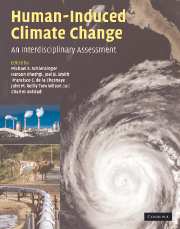Book contents
- Frontmatter
- Contents
- List of contributors
- Preface
- Part I Climate system science
- Part II Impacts and adaptation
- Part III Mitigation of greenhouse gases
- 15 Bottom-up modeling of energy and greenhouse gas emissions: approaches, results, and challenges to inclusion of end-use technologies
- 16 Technology in an integrated assessment model: the potential regional deployment of carbon capture and storage in the context of global CO2 stabilization
- 17 Hydrogen for light-duty vehicles: opportunities and barriers in the United States
- 18 The role of expectations in modeling costs of climate change policies
- 19 A sensitivity analysis of forest carbon sequestration
- 20 Insights from EMF-associated agricultural and forestry greenhouse gas mitigation studies
- 21 Global agricultural land-use data for integrated assessment modeling
- 22 Past, present, and future of non-CO2 gas mitigation analysis
- 23 How (and why) do climate policy costs differ among countries?
- 24 Lessons for mitigation from the foundations of monetary policy in the United States
- Part IV Policy design and decisionmaking under uncertainty
- Index
- Plate section
- References
17 - Hydrogen for light-duty vehicles: opportunities and barriers in the United States
from Part III - Mitigation of greenhouse gases
Published online by Cambridge University Press: 06 December 2010
- Frontmatter
- Contents
- List of contributors
- Preface
- Part I Climate system science
- Part II Impacts and adaptation
- Part III Mitigation of greenhouse gases
- 15 Bottom-up modeling of energy and greenhouse gas emissions: approaches, results, and challenges to inclusion of end-use technologies
- 16 Technology in an integrated assessment model: the potential regional deployment of carbon capture and storage in the context of global CO2 stabilization
- 17 Hydrogen for light-duty vehicles: opportunities and barriers in the United States
- 18 The role of expectations in modeling costs of climate change policies
- 19 A sensitivity analysis of forest carbon sequestration
- 20 Insights from EMF-associated agricultural and forestry greenhouse gas mitigation studies
- 21 Global agricultural land-use data for integrated assessment modeling
- 22 Past, present, and future of non-CO2 gas mitigation analysis
- 23 How (and why) do climate policy costs differ among countries?
- 24 Lessons for mitigation from the foundations of monetary policy in the United States
- Part IV Policy design and decisionmaking under uncertainty
- Index
- Plate section
- References
Summary
Underlying energy policy issues
Three fundamental issues are now explicit in energy policy – at least in US energy policy – and have been explicit or implicit in energy policy at least since the very early 1970s:
Reducing environmental impacts of energy production, distribution, use;
Providing security against supply system disruption;
Supplying and using plentiful energy at a reasonable cost.
This paper relates these issues to the quest for a new energy carrier – molecular hydrogen – which might take a place comparable to that of electricity. The paper focuses attention on molecular hydrogen for use in light duty vehicles.
The United States has learned or is learning to deal with most of the worst environmental impacts of energy use. But there is one problem we have not learned to control – carbon dioxide (CO2) releases from combustion of fossil fuels.
Internationally, the Kyoto Protocol is a response but it has been rejected in the United States. The protocol tells what commitments are expected by various countries but does nothing to make such changes economically viable. To meet the goals requires not simply institutional and economic changes, it needs technological advances.
Figure 17.1 provides 2003 data on US sources of CO2 emissions (EPA, 2005). The largest two sources are coal in electricity generation and petroleum in transportation, particularly in light duty vehicles. Technologies that reduce CO2 from electricity generation or from transportation vehicles could, in principle, be very important for addressing this serious environmental problem.
- Type
- Chapter
- Information
- Human-Induced Climate ChangeAn Interdisciplinary Assessment, pp. 198 - 215Publisher: Cambridge University PressPrint publication year: 2007

